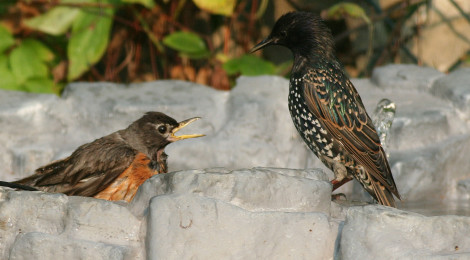
How to Handle Baby Birds and Sick Birds
Often times a bird feeder is a vibrant and happy part of any individual’s garden or yard, but unfortunately every once in a great while you may encounter a lost baby bird or even a dead bird around your home with no clear culprit. While this may be a rare occurrence, how to properly handle a baby bird or diagnose and dispose of a dead bird is an important aspect of being a good steward of nature.
For a baby bird, the first thing to do is to establish whether or not the bird is a nestling or a fledgling. Sparsely feathered infant birds that are incapable of walking or flitting around are nestlings, and their home is almost certainly somewhere nearby. If you can find the nest, put the bird back as quickly and carefully as possible, wearing gloves of some kind. You don’t have to worry about the parents detecting your scent and potentially euthanizing their young—adult birds don’t detect their babies by smell.
If the bird is feathered and hopping around, and if its toes can grip your finger or a twig, then it’s a fledgling. While it may be tempting to assume that the little one is lost or abandoned, it is almost certain death for the bird for a human to adopt it. Fledglings need a very specialized diet that only trained ornithological professionals or their parents can provide. They need to learn how to sing and fly, things that humans may attempt to do, but generally will be unable to do. The vast majority of displaced fledglings are perfectly healthy and may not appear to be cared for, but their parents are nearby. Just like humans, birds with four or five little ones sometime have a hard time keeping them corralled in one place and may be attending to other babies scattered all over the area. They will most likely return for their young, so the best thing to do is to make sure there are no cats or other animals around to get to them before their parents do. People have a general misconception that a nest is a safe and cozy place for baby birds, but it’s best for the birds to attempt to fly as soon as possible. A nest is actually a pretty easy target after the babies start to vocalize, and moreover, a hotbed for parasites.
If you find a fledgling and have established beyond a doubt that its parents are in fact missing or have been killed by another animal themselves, the best course of action is to contact your local wildlife rehabilitation center. Your local zoo or Bird Center can provide more emergency care information until you can get the little one to them.
If you do have the unfortunate luck of finding a sick, injured or dead bird, there is a proper way to treat the situation or dispose of the body. A sick bird is actually more common around bird feeders than you might think—sick birds are drawn to feeders for an easy meal. The first step is to call your local veterinarian to see if they’ll take it in. In any case, never handle or transport a potentially sick bird without disposable gloves and a box ready. Capture is a traumatic experience for a bird, and you can do unintentional damage if you’re not careful. Cleaning your feeder regularly can help minimize the spread of diseases among birds. If you discover several sick birds, take down all your feeders for at least 5 to 7 days and clean them to quarantine the area and provide a buffer zone for disease to disperse. Birdbaths may also be culprit, so be aware of this as well.
A dead bird with no discernible cause of death is sometimes interesting to local health departments or disease control centers. You should contact your local county health department or the National Wildlife Health Center for more information. You may also be interested to know that local universities, high schools and museums with the right permits may be interested in preserving the bird for science or display. If you pursue this route, note the location, date found, and species 9if you are able to identify it). The best course of action is usually to put the bird in a plastic bag and freeze it if you are unable to bring it to the proper authorities fairly soon. If the bird is decayed beyond use or if you have no interest in any of these options, the best course of action is to bury it at least 8-10 inches below the ground to allow quick and efficient decomposition and reintegration of its body.
BIO: Soleil Ho is a fanatical birdwatcher and outdoorswoman who will talk your ear off about survival knives, bushcraft, and pretty little birdies. She regularly contributes her expertise to Backyard Chirper.
